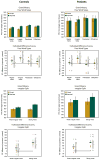The role of Broca's area in regular past-tense morphology: an event-related potential study
- PMID: 21035476
- PMCID: PMC3026293
- DOI: 10.1016/j.neuropsychologia.2010.10.027
The role of Broca's area in regular past-tense morphology: an event-related potential study
Abstract
It has been suggested that damage to anterior regions of the left hemisphere results in a dissociation in the perception and lexical activation of past-tense forms. Specifically, in a lexical-decision task in which past-tense primes immediately precede present-tense targets, such patients demonstrate significant priming for irregular verbs (spoke-speak), but, unlike control participants, fail to do so for regular verbs (looked-look). Here, this behavioral dissociation was first confirmed in a group of eleven patients with damage to the pars opercularis (BA 44) and pars triangularis (BA 45) of the left inferior frontal gyrus (i.e., Broca's area). Two conditions containing word-onset orthographic-phonological overlap (bead-bee, barge-bar) demonstrated that the disrupted regular-verb priming was accompanied by, and covaried with, disrupted ortho-phonological priming, regardless of whether prime stimuli contained the regular inflectional rhyme pattern. Further, the dissociation between impaired regular-verb and preserved irregular-verb priming was shown to be continuous rather than categorical; priming for weak-irregular verbs (spent-spend) was intermediate in size between that of regular verbs and strong verbs. Such continuous dissociations grounded in ortho-phonological relationships between present- and past-tense forms are predicted by single-system, connectionist approaches to inflectional morphology and not predicted by current dual-system, rule-based models. Event-related potential data demonstrated that N400 priming effects were intact for both regular and irregular verbs, suggesting that the absence of significant regular-verb priming in the response time data did not result from a disruption of lexical access, and may have stemmed instead from post-lexical events such as covert articulation, segmentation strategies, and/or cognitive control.
Copyright © 2010 Elsevier Ltd. All rights reserved.
Figures




Similar articles
-
An Event-Related Potential Study of Cross-modal Morphological and Phonological Priming.J Neurolinguistics. 2009 Nov 1;22(6):584-604. doi: 10.1016/j.jneuroling.2009.07.001. J Neurolinguistics. 2009. PMID: 20160930 Free PMC article.
-
Interpreting dissociations between regular and irregular past-tense morphology: evidence from event-related potentials.Cogn Affect Behav Neurosci. 2008 Jun;8(2):178-94. doi: 10.3758/cabn.8.2.178. Cogn Affect Behav Neurosci. 2008. PMID: 18589508 Free PMC article.
-
They played with the trade: MEG investigation of the processing of past tense verbs and their phonological twins.Neuropsychologia. 2012 Dec;50(14):3713-20. doi: 10.1016/j.neuropsychologia.2012.10.019. Epub 2012 Oct 24. Neuropsychologia. 2012. PMID: 23103839 Free PMC article.
-
Impairments of lexical-semantic processing in aphasia: evidence from the processing of lexical ambiguities.Brain Lang. 1993 Aug;45(2):189-232. doi: 10.1006/brln.1993.1043. Brain Lang. 1993. PMID: 8358597 Review.
-
Broca's area and inflectional morphology: evidence from broca's aphasia and computer modeling.Cortex. 2006 May;42(4):563-76. doi: 10.1016/s0010-9452(08)70395-2. Cortex. 2006. PMID: 16881267 Review.
Cited by
-
An Event-Related Potential Study of Cross-modal Morphological and Phonological Priming.J Neurolinguistics. 2009 Nov 1;22(6):584-604. doi: 10.1016/j.jneuroling.2009.07.001. J Neurolinguistics. 2009. PMID: 20160930 Free PMC article.
-
Gradients versus dichotomies: how strength of semantic context influences event-related potentials and lexical decision times.Cogn Affect Behav Neurosci. 2014 Sep;14(3):1086-103. doi: 10.3758/s13415-013-0223-1. Cogn Affect Behav Neurosci. 2014. PMID: 24310943
-
Improving language mapping in clinical fMRI through assessment of grammar.Neuroimage Clin. 2017 May 26;15:415-427. doi: 10.1016/j.nicl.2017.05.021. eCollection 2017. Neuroimage Clin. 2017. PMID: 28616382 Free PMC article.
-
The production of nominal and verbal inflection in an agglutinative language: evidence from Hungarian.PLoS One. 2015 Mar 13;10(3):e0119003. doi: 10.1371/journal.pone.0119003. eCollection 2015. PLoS One. 2015. PMID: 25769039 Free PMC article.
References
-
- Aydelott Utman J, Blumstein SE, Sullivan K. Mapping from sound to meaning: Reduced lexical activation in Broca’s aphasics. Brain and Language. 2001;79:444–472. - PubMed
-
- Baayen RH, Piepenbrock R, Gulikers L. Linguistic Data Consortium. University of Pennsylvania; Philadelphia, PA: 1995. The CELEX Lexical Database (CD-ROM)
-
- Baddeley A. Working Memory. Oxford: Oxford University Press; 1986.
-
- Badre D, Wagner AD. Left ventrolateral prefrontal cortex and the cognitive control of memory. Neuropsychologia. 2007;45:2883–2901. - PubMed
-
- Baldo JV, Dronkers NF. The role of inferior parietal and inferior frontal cortex in working memory. Neuropsychology. 2006;20:529–538. - PubMed
Publication types
MeSH terms
Grants and funding
LinkOut - more resources
Full Text Sources
Medical
Miscellaneous

